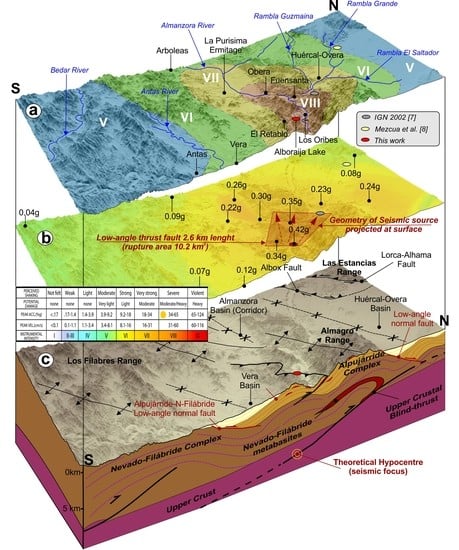Reappraisal of the 1863 Huércal-Overa Earthquake (Betic Cordillera, SE Spain) by the Analysis of ESI-07 Environmental Effects and Building Oriented Damage
Abstract
1. Introduction
2. The 1863 Huércal-Overa Earthquake
3. Morphotectonic Framework of the Huercal-Overa Earthquake
4. Earthquake Environmental Effects (EEEs)
4.1. Environmental Effects (EEEs) in the Epicentral Area (Almanzora Gorge)
4.2. Environmental Effects around the Locality of Huércal-Overa
4.3. Environmental Effects in Cuevas de Almanzora, Vera and El Jaroso Mining District (Almagro Range)
5. Earthquake Archaeological Effects (EAE) on the Cultural Heritage of the Area
6. Discussion
7. Conclusions
- Intensity VII affected the Huércal-Overa village, but the real macroseismic zone was located to the south (Almanzora Gorge), reaching a maximum intensity VIII ESI-07 based on natural effects (EEEs). The EMS-ESI hybrid intensity map produced for this earthquake (Figure 2 and Figure 11) clearly illustrates the advantage to combine both intensity scales.
- The analysis of oriented damage in buildings of the cultural heritage of the area (EAEs), also identified the same macroseismic zone. Despite the recent restorations of most of the affected buildings, available historical descriptions and field inspections help to identify a dominant ground movement in an N-S to NNE-SSW orientation in the localities of Huércal and Cuevas. In the case of the demolished buildings ancient photographs available in different websites facilitated the identification of preferential orientations of structural damage (Figure 9). To the East of the epicenter, data from La Purisima Chapel and the ancient Obera Castle are not conclusive and to the West there is any macroseismic data (Figure 2).
- This work characterizes the northward crustal blind-thrusting beneath the Almagro Range as the more reliable seismic source for the studied event (Figure 11). Most of the documented environmental damage were concentrated south of the locality of Huércal-Overa, above the upthrown block of the above-mentioned tectonic structure. In this sense, the temporary stop in the water-flow of the Almanzora River, changes in elevation of springs and the disappearance of the Albojaira Lake reported by De Prado [4], will indicate transient coseismic uplift of the upthrown block of the thrust located downstream (Figure 2). Geophysical data indicate that such structure is a low-angle discontinuity verging to the north which develops between c. 9 km (south) to 3 km (north) depth beneath the Almagro Range [25,26] (Figure 11c). In detail, available seismological data indicate that most of the instrumental seismicity in this zone is recorded along and above (shallow events) the blind-thrust with focal solutions compatible with reverse to strike-slip displacements [26].
- The possibly shallow nature of this low-magnitude event (4.9 Mw), can explain the variety and size of the triggered EEEs. The computed maximum PGA values (0.35–0.38 g) at Los Oribes—Albojaira lake zone (Figure 11b) are in the lower range of intensity VIII ESI-07 (Figure 11a). A comparable maximum PGA of 0.365 g was instrumentally recorded during the 2011 Lorca earthquake (5.1 Mw) in SE Spain [13,47]. This event triggered a total of 251 EEEs, most of them slope movements within intensity zones VI to VIII ESI-07 (135 km2) [46], but also a large amount of oriented building damage (EAEs) in the city of Lorca consistent with the location of the epicenter and preferent ground movement [16]. Considering the differences in population, construction styles and epoch, it can be said that the 1863 Huércal-Overa and the 2011 Lorca earthquakes are comparable in size and had comparable effects. In both cases, the macroseismic areas (whit intensity VIII EEEs) was few kilometers outside of the populated areas [20,39] becoming invisible to EMS analyses and resulting in the underestimation of maximum intensities [7,46].
Supplementary Materials
Author Contributions
Funding
Acknowledgments
Conflicts of Interest
Appendix A
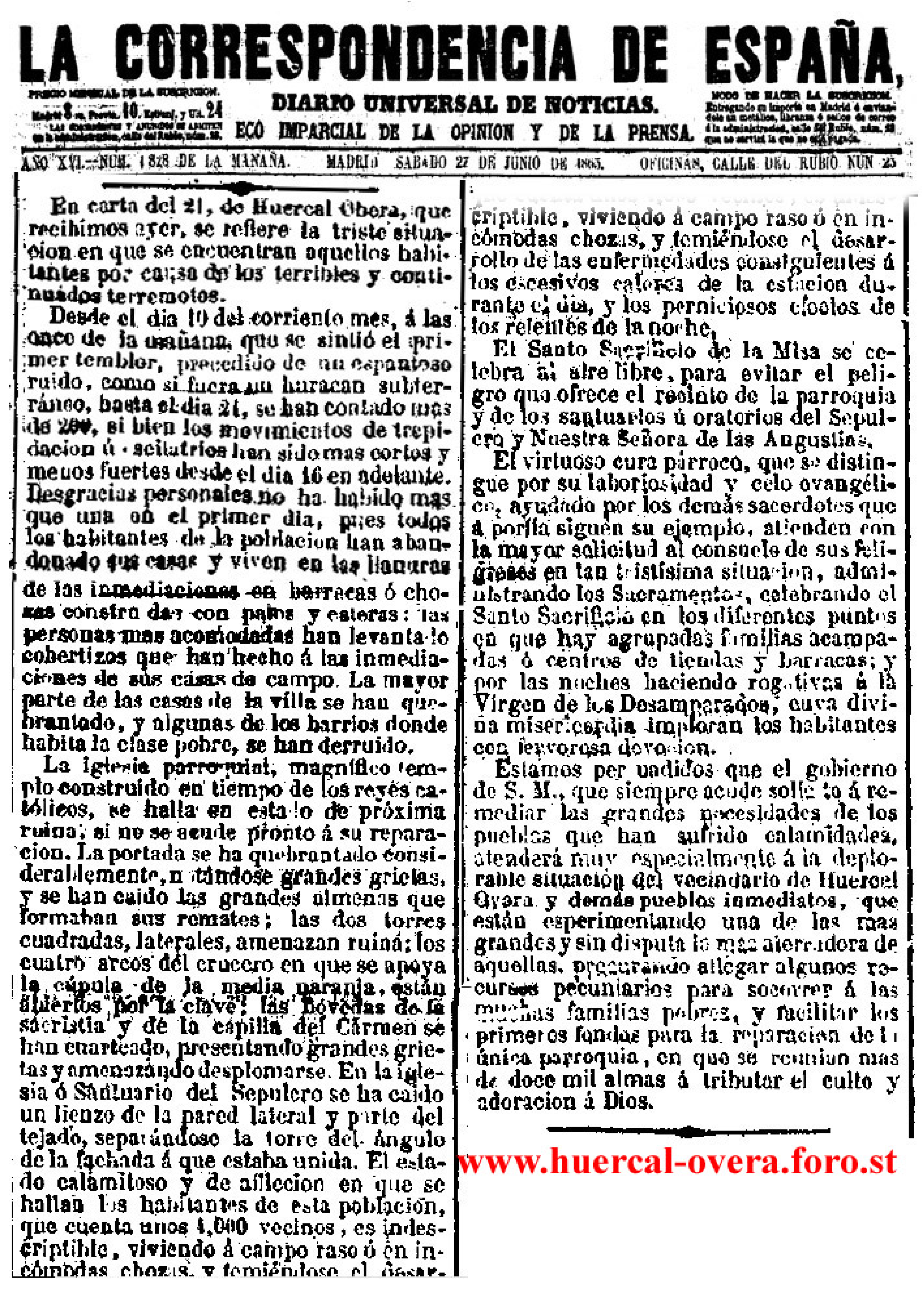
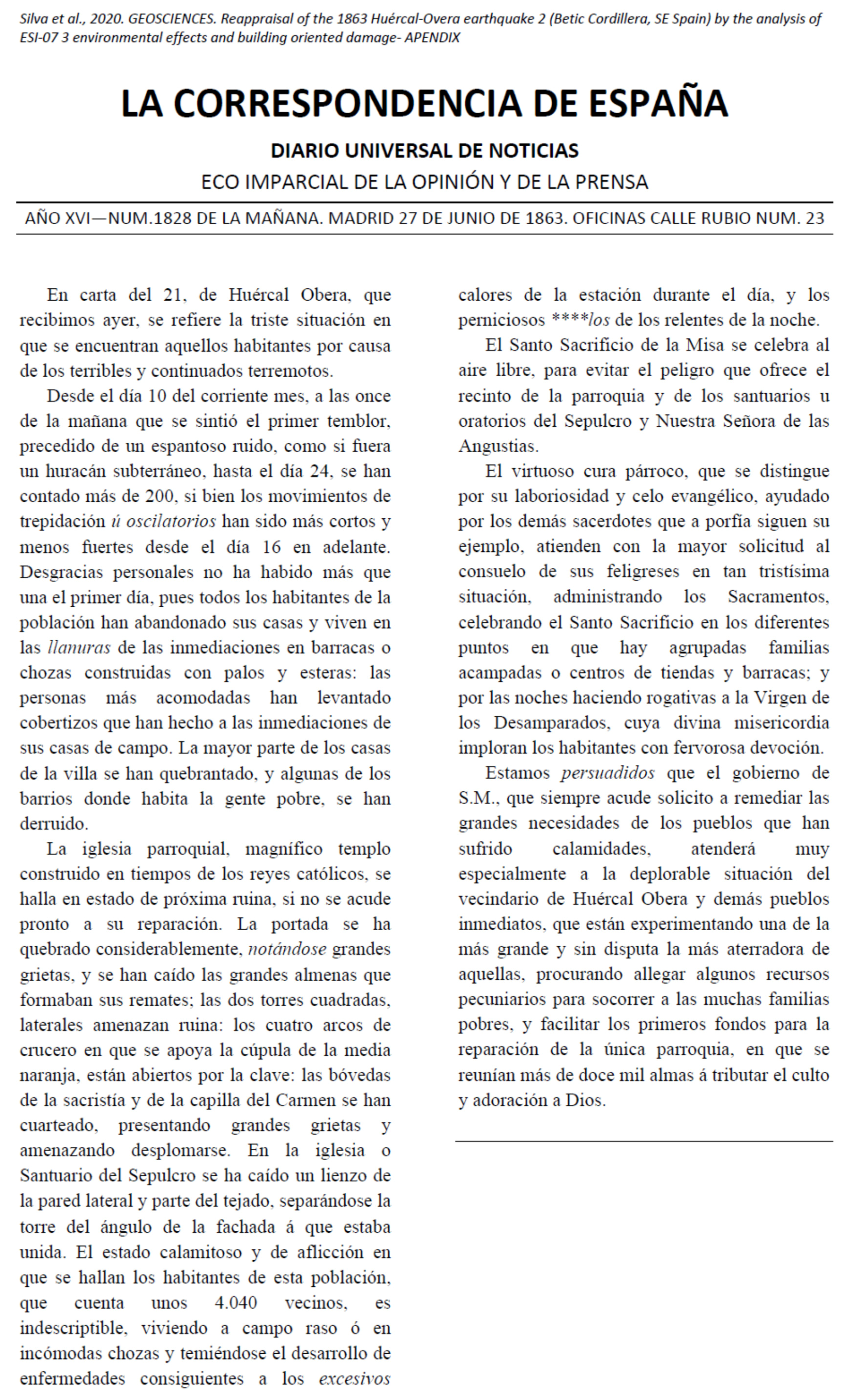
References
- Michetti, A.M.; Esposito, E.; Guerrieri, L.; Porfido, S.; Serva, L.; Tatevossian, R.; Vittori, E.; Audemard, F.; Azuma, T.; Clague, J.; et al. Environmental seismic Intensity Scale ESI 2007. Mem. Descr. Carta Geol. D’Italia 2007, 74, 11–20. [Google Scholar]
- Grünthal, G. European Macroseismic Scale 1998: EMS98; Musée Natioal d´Historie Narurelle: Luxembourg, 1988; p. 99. [Google Scholar]
- Silva, P.G.; Guerrieri, L.; Michetti, A.M. Intensity scale ESI 2007 for assessing earthquake intensities. In Encyclopedia of Earthquake Engineering; Beer, M., Kougioumtzoglou, I.A., Patelli, E., Au, S.K., Eds.; Springer: Berlin, Germany, 2015; pp. 1219–1237. [Google Scholar]
- De Prado, C. Los terremotos de la Provincia de Almería. Rev. Min. 1863, 14, 180. [Google Scholar]
- Fernández Bolea, E. Los terremotos de 1863 en la comarca del Levante almeriense. Espiral Cuad. Prof. 2009, 2, 27–40. [Google Scholar]
- García Asensio, E. Historia de la Villa de Huércal-Overa y su Comarca Precedida de un Estudio Físico-geológico de la Cuenca del río Almanzora; Martínez y Gimenez: Barcelona, Spain, 1908; p. 295. [Google Scholar]
- Martínez Solares, J.M.; Mezcua, J. Catálogo Sísmico de la Península Ibérica (880 a.C. – 1900); Instituto Geográfico Nacional: Madrid, Spain, 2002; p. 253. [Google Scholar]
- Mezcua, J.; Rueda, J.; García Blanco, R.M. Iberian Peninsula Historical Seismicity Revisited: An Intensity Data Bank. Seism. Res. Let. 2013, 84, 9–18. [Google Scholar] [CrossRef]
- Rodríguez-Pascua, M.A.; Pérez-López, R.; Silva, P.G.; Giner-Robles, J.L.; Garduño-Monroy, V.H.; Reicherter, K. A Comprehensive Classification of Earthquake Archaeological Effects (EAE) for Archaeoseismology. Quat. Int. 2011, 242, 20–30. [Google Scholar]
- IGN. Actualización de Mapas de Peligrosidad Sísmica en España 2012; Instituto Geográfico Nacional (IGN): Madrid, Spain, 2013; p. 127. [Google Scholar]
- Silva, P.G.; Elez, J.; Giner-Robles, J.L.; Rodríguez-Pascua, M.A.; Pérez-López, R.; Roquero, E.; Bardají, T.; Martínez-Graña, A.M. ESI-07 ShakeMaps for instrumental and historical events in the Betic Cordillera (SE Spain): An approach based on geological data and applied to seismic hazard. Quat. Int. 2017, 451, 185–208. [Google Scholar] [CrossRef]
- Atkinson, G.M.; Kaka, S.I. Relationship between felt intensity and instrumental ground motion in the central United States and California. Bull. Seism. Soc. Am. 2007, 97, 497–510. [Google Scholar] [CrossRef]
- Faenza, L.; Michelini, F. Regression analysis of MCS intensity and ground motion parameters in Italy and its application in ShakeMaps. Geophys. J. Int. 2010, 180, 1138–1152. [Google Scholar] [CrossRef]
- Wald, D.J.; Worden, B.C.; Quitoriano, V.; Pankow, K.L. ShakeMap Manual: Technical Manual, User’s Guide, and Software Guide; U.S. Geological Survey: Boulder, CO, USA, 2005; p. 132.
- Worden, C.B.; Gerstenberger, M.C.; Rhoades, D.A.; Wald, D.J. Probabilistic relationships between ground-motion parameters and Modified Mercalli intensity in California. Bull. Seism. Soc. Am. 2012, 102, 204–221. [Google Scholar] [CrossRef]
- Rodríguez-Pazcua, M.A.; Pérez-López, R.; Martín-González, F.; Giner-Robles, J.L.; Silva, P.G. Efectos arquitectónicos del terremoto de Lorca del 11 de mayo de 2011. Neoformación y reactivación de efectos en el Patrimonio Cultural. Bol. Geol. Min. 2012, 123, 487–502. [Google Scholar]
- Giner-Robles, J.L.; Rodríguez-Pascua, M.A.; Silva, P.G.; Pérez-López, R. Efectos sísmicos en yacimientos arequeológicos: Catalogación y cuantificación arqueosismológica. Bol. Geol. Min. 2018, 129, 451–467. [Google Scholar]
- IAEA. The Contribution of Paleoseismology to Seismic Hazard Assessment in Site Evaluation for Nuclear Installations; TEC-DOC 1767; International Atomic Energy Agency: Vienna, Austria, 2015; p. 206. [Google Scholar]
- Martínez Solares, J.M. Los efectos en España del terremoto de Lisboa; Dirección General del Instituto Geográfico Nacional (IGN): Madrid, Spain, 2001; p. 756. [Google Scholar]
- Silva, P.G.; Rodríguez-Pascua, M.A.; Giner-Robles, J.L.; Roquero, E.; Pérez-López, R.; Huerta, P.; Bardají, T. Anatomy of an Earthquake: Geological analysis of the Huércal-Overa AD 1863 event (Almería, SE Spain). In Proceedings 2ª Reunión Ibérica sobre Fallas Activas y Paleosismología; IBERFAULT II: Lorca, Spain, 2014; pp. 145–148. [Google Scholar]
- Silva, P.G.; Rodríguez-Pascua, M.; Giner-Robles, J.; Elez, J.; Huerta, P.; García-Tortosa, F.J.; Azcárate, T.; Perucha, M.A.; Gómez-Diego, P.V.; Perez-Lopez, R.; et al. Catálogo de los efectos geológicos de los terremotos de España, 2ª Ed. Revisada y Ampliada; Serie Riesgos Geológicos y Geotecnia 6; Instituto Geológico y Minero de España (IGME): Madrid, Spain, 2019; p. 804. [Google Scholar]
- La Correspondencia de España. Diario universal de noticias, 18 de junio de 1863, nº 1809 (Año XVI); 27 de junio de 1863, nº 1828 (Año XVI). Digital Repository of the Spanish National Library: Madrid, Spain. Available online: http://hemerotecadigital.bne.es/ (accessed on 9 July 2020).
- Madoz, P. Diccionario Geográfico-Estadístico-Histórico de España y sus posesiones de Ultramar (Provincia de Almería), 1845-50; Ámbito y Editorial Andaluzas Unidas: Sevilla, Spain, 1988; p. 191. [Google Scholar]
- Espinar Moreno, M. Los terremotos históricos de la provincia de Almería. In El estudio de los terremotos en Almería; Instituto de Estudios Almerienses: Almería, Spain, 1994; pp. 115–180. [Google Scholar]
- Pedrera, A.; Galindo-Zaldívar, J.; Sanz de Galdeano, C.; López-Garrido, A.C. Fold and fault interactions during the development of an elongated narrow basin: The Almanzora Neogene-Quaternary Corridor (SE Betic Cordillera, Spain). Tectonics 2007, 26, TC6002. [Google Scholar] [CrossRef]
- Pedrera, A.; Galindo-Zaldívar, J.; Ruíz-Constán, A.; Duque, C.; Marín-Lechado, C.; Serrano, I. Recent large fold nucleation in the upper crust: Insight from gravity, magnetic, magnetotelluric and seismicity data (Sierra de Los Filabres–Sierra de Las Estancias, Internal Zones, Betic Cordillera). Tectonophysics 2009, 463, 145–160. [Google Scholar] [CrossRef]
- Silva, P.G.; Goy, J.L.; Somoza, L.; Zazo, C.; Bardají, T. Landscape response to strike-slip faulting linked to collisional settings: Quaternary tectonics and basin formation in the Eastern Betics, Southeast Spain. Tectonophysics 1993, 224, 289–303. [Google Scholar] [CrossRef]
- García-Meléndez, E.; Goy, J.L.; Zazo, C. Neotectonics and Plio-Quaternary landscape development within the eastern Huércal-Overa Basin (Betic Cordillera, south-eastern Spain). Geomorphology 2003, 50, 111–133. [Google Scholar] [CrossRef]
- Masana, E.; Pallàs, R.; Perea, H.; Ortuño, M.; Martínez-Díaz, J.J.; García-Meléndez, E.; Santanach, P. Large Holocene morphogenic earthquakes along the Albox fault, Betic Cordillera, Spain. J. Geodyn. 2005, 40, 119–133. [Google Scholar] [CrossRef]
- Stokes, M.; Mather, A.E. Tectonic origin and evolution of a transverse drainage: The Rio Almanzora, Betic Cordillera, Southeast Spain. Geomorphology 2003, 50, 59–81. [Google Scholar] [CrossRef]
- Audemard, F.; Azuma, T.; Baiocco, F. Earthquake environmental effect for seismic hazard assessment: The ESI intensity scale and the EEE catalogue. In Memorie Descrittive della Carta Geologica d’Italia; Guerrieri, L., Ed.; ISPRA: Rome, Italy, 2015; Volume XCVII. [Google Scholar]
- Junta de Andalucia. Manatiales y Fuentes de Andalucia; CSIC-Universidad de Granada: Granada, Spain; Available online: http://www.conocetusfuentes.com/datos_fuente_6653.html (accessed on 20 March 2020).
- García-Tortosa, F.J.; López Casado, A.C.; Sanz de Galdeano, C. Estratigrafía y estructura de la Unidad de Los Tres Pacos: La controversia sobre el Complejo “Almagride” en la Sierra de Almagro (Cordillera Bética, Almería). Rev. Soc. Geol. Esp. 2002, 15, 15–25. [Google Scholar]
- La Esperanza, Periódico Monárquico. 17 de junio de 1863, nº 5732 (Año XIX), Bibliotéca Nacional de España, Madrid. Available online: http://hemerotecadigital.bne.es/ (accessed on 9 July 2020).
- Bretón González, M.; Espinar Moreno, M.; Grima Cervantes, J.; Vidal Sánchez, F. El Terremoto de 1518 en Vera y su comarca (Almería); Aráez Editores: Almería, Granada, 2014; p. 286. [Google Scholar]
- Fontenla Ballesta, S. Huércal y Overa Medievales; Editorial Fajardo: Murcia, Spain, 1989; p. 223. [Google Scholar]
- Cofradía del Paso Negro, Huercal-Overa. Available online: https://pasonegro.org/historia-y-origen/ (accessed on 10 January 2020).
- López Cazorla, L. Pinceladas sobre Almanzora. Rev. Cult. Cantoria 2006, 1, 2–10. [Google Scholar]
- Wells, D.L.; Coppersmith, K.J. New empirical relationships among magnitude, rupture length, rupture width, rupture area, and surface displacement. Bull. Seism. Soc. Am. 1994, 84, 974–1002. [Google Scholar]
- Serva, L. History of the Environmental Seismic Intensity Scale ESI-07. Geosciences 2019, 9, 210. [Google Scholar] [CrossRef]
- Valente, E.; Ascione, A.; Ciotoli, G.; Cozzolino, M.; Porfido, S.; Sciarra, A. Do moderate magnitude earthquakes generate seismically induced ground effects? The case study of the M w = 5.16, 29th December 2013 Matese earthquake (southern Apennines, Italy). Int. J. Earth Sci. 2018, 107, 517–537. [Google Scholar] [CrossRef]
- Nappi, R.; Alessio, G.; Gaudiosi, G.; Nave, R.; Marotta, E.; Siniscalchi, V.; Civico, R.; Pizzimenti, L.; Peluso, R.; Belviso, P.; et al. The 21 August 2017 Md 4.0 Casamicciola Earthquake: First Evidence of Coseismic Normal Surface Faulting at the Ischia Volcanic Island. Seism. Res. Let. 2018, 89, 1323–1334. [Google Scholar] [CrossRef]
- Gosar, A. Review of seismological investigations related to 1998 Mw5.6 and 2004 Mw5.2 earthquakes in Krn Mountains. Geologija 2018, 62, 61–73. [Google Scholar] [CrossRef]
- Pavlides, S.; Papathanassiou, G.; Valkaniotis, S.; Chatzipetros, A.; Sboras, S.; Caputo, R. Rock-falls and liquefaction related phenomena triggered by the June 8, 2008, Mw=6.4 earthquake in NW Peloponnesus, Greece. Ann. Geophys. 2013, 56, S0682. [Google Scholar]
- Naik, S.P.; Kim, Y.-S.; Kim, T.; Su-Ho, Y. Geological and Structural Control on Localized Ground Effects within the Heunghae Basin during the Pohang Earthquake (MW 5.4, 15th November 2017), South Korea. Geosciences 2019, 9, 173. [Google Scholar] [CrossRef]
- Silva, P.G.; Pérez-López, R.; Rodríguez-Pascua, M.A.; Roquero, E.; Giner Robles, J.L.; Huerta, P.; Martínez-Graña, A.; Bardají, T. Macroseismic analysis of slope movements triggered by the 2011 Lorca Earthquake (Mw 5.1): Application of the ESI-07 scale. Geogaceta 2015, 57, 35–38. [Google Scholar]
- Morales, J.; Cantavella, J.V.; Mancilla, F.L.; Lozano, L.; Stich, D.; Herráiz, E.; Martín, J.B.; López-Comino, J.A.; Martínez-Solares, J.M. The 2011 Lorca seismic series: Temporal evolution, faulting parameters and hypocentral relocation. Bull Earthq. Eng. 2014, 12, 1871–1888. [Google Scholar] [CrossRef]
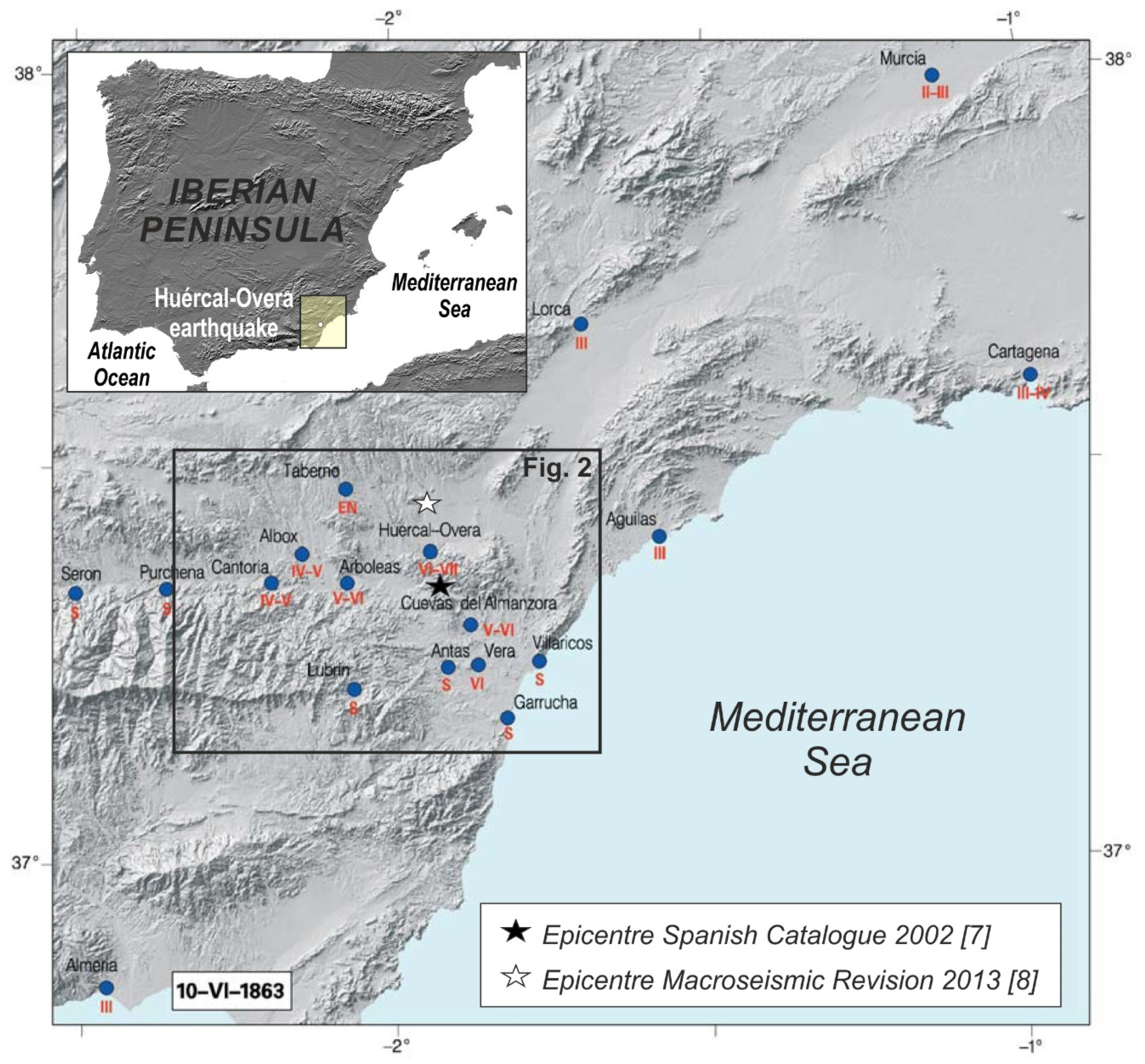

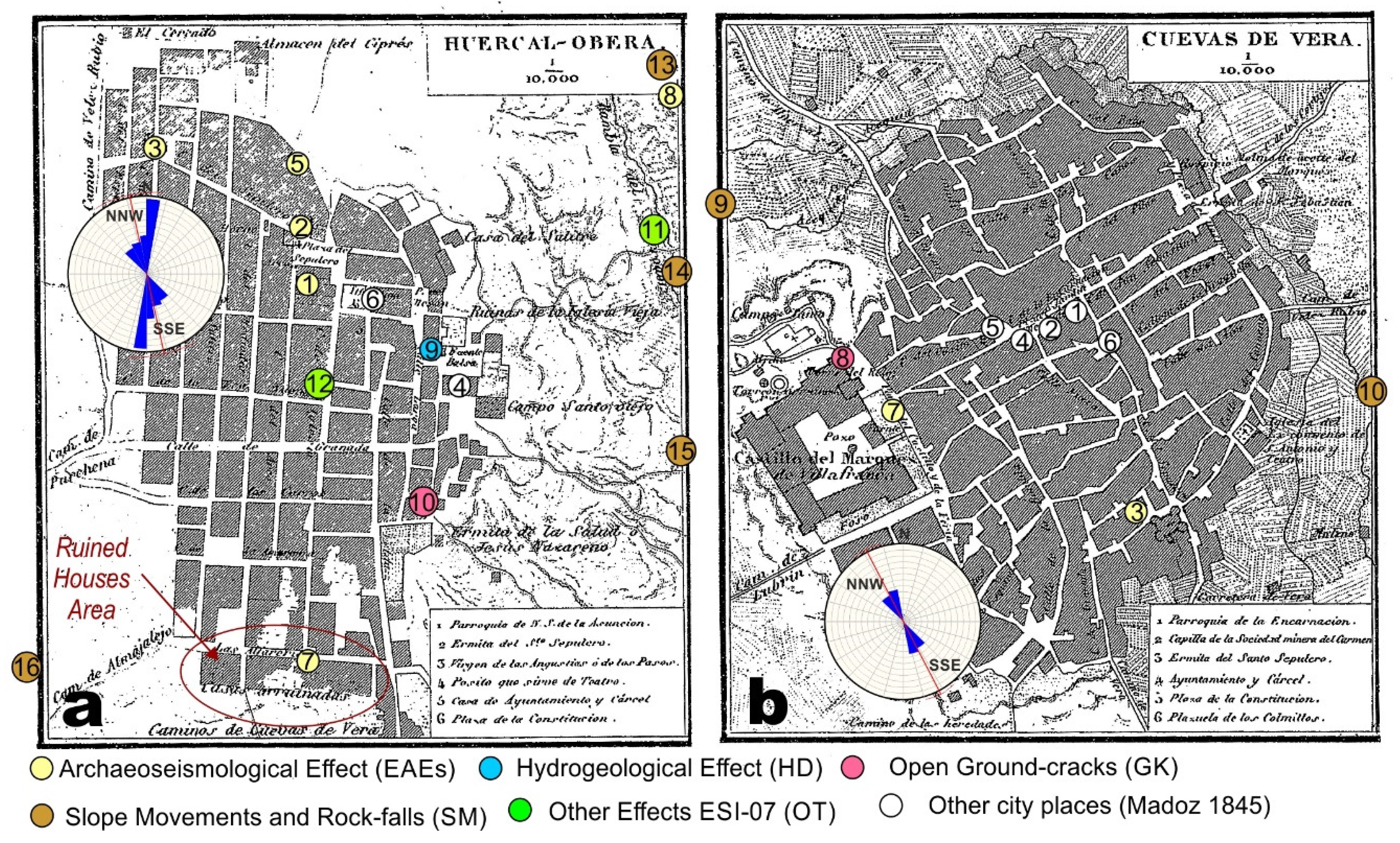
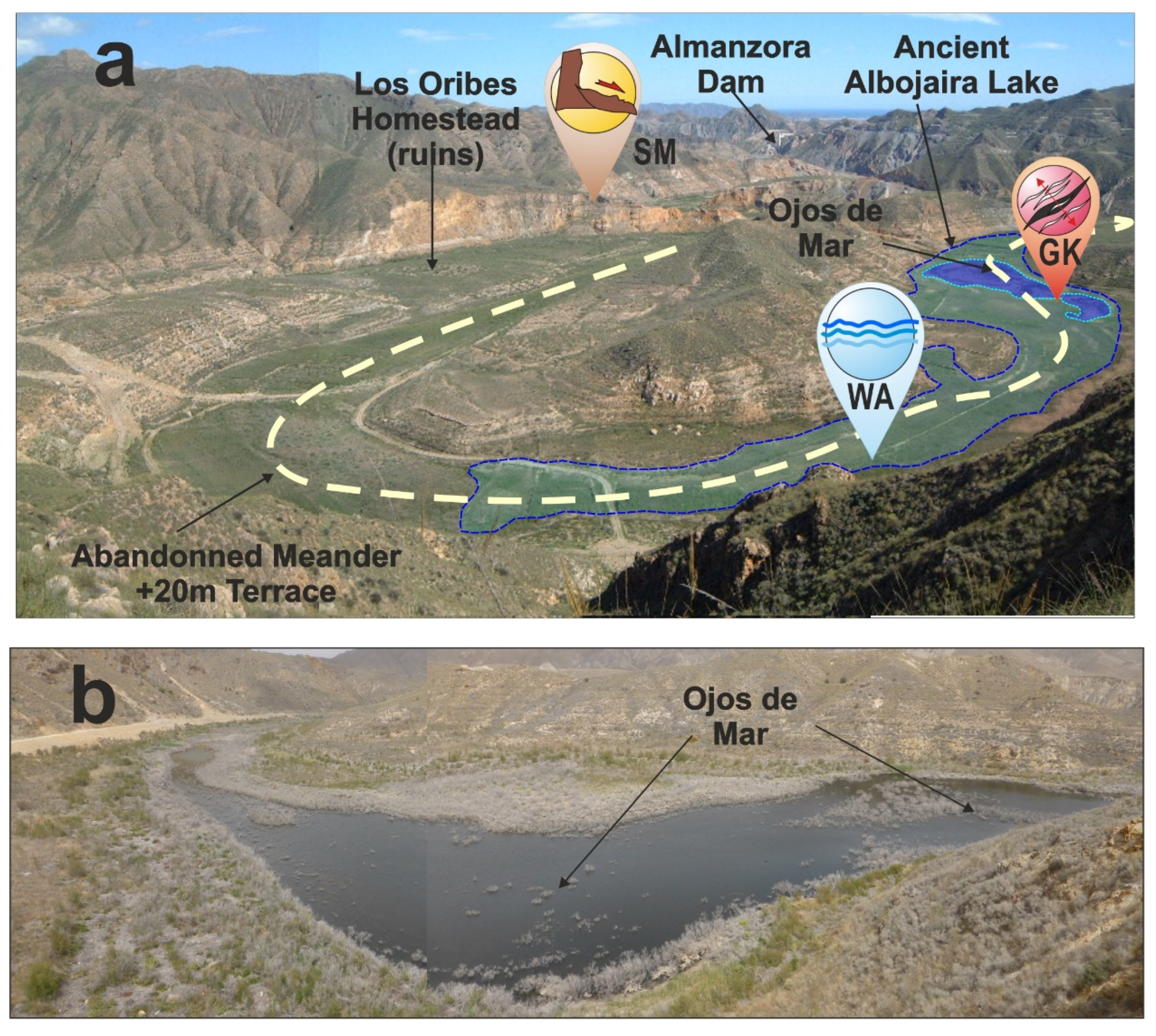

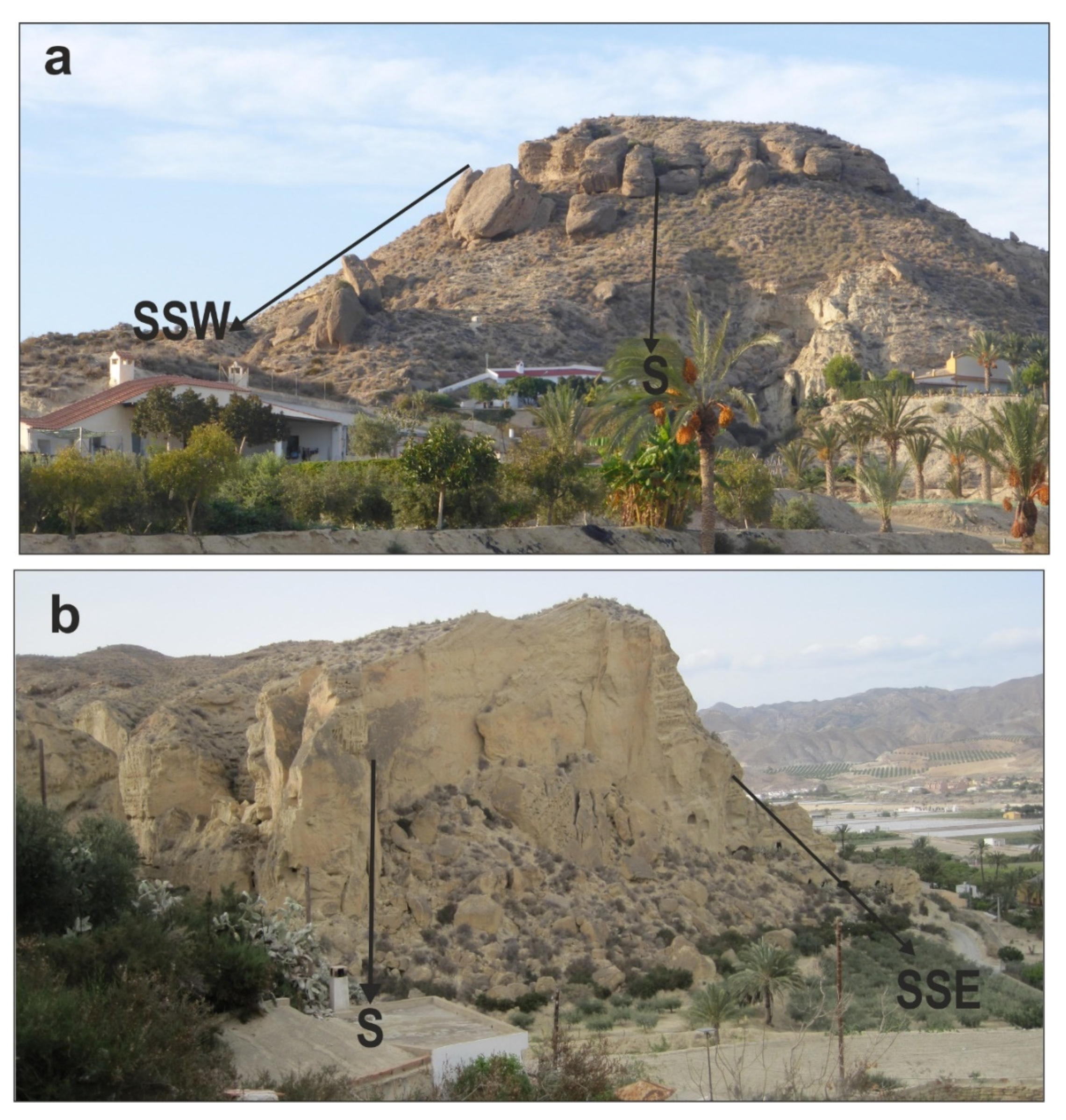
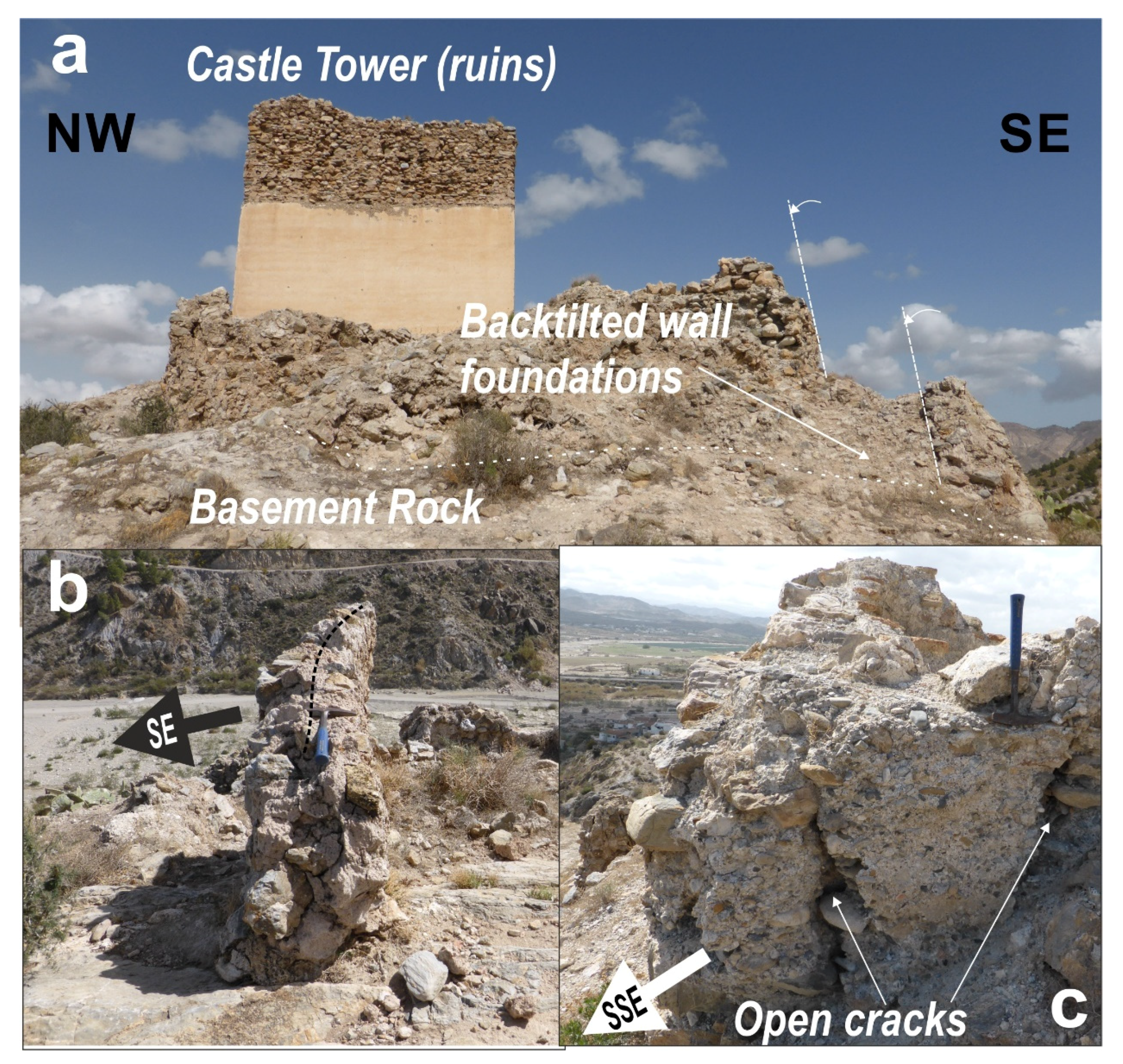
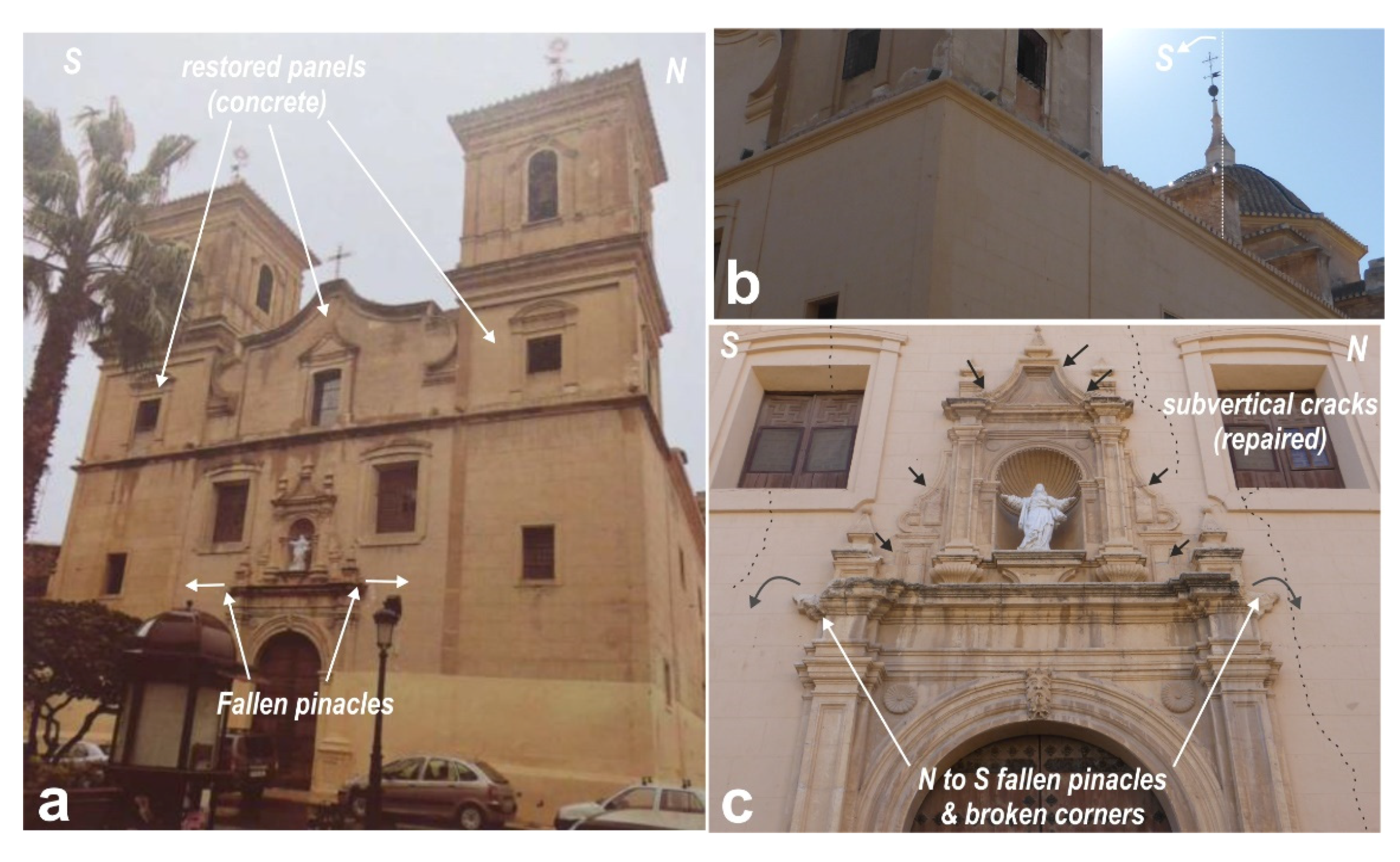
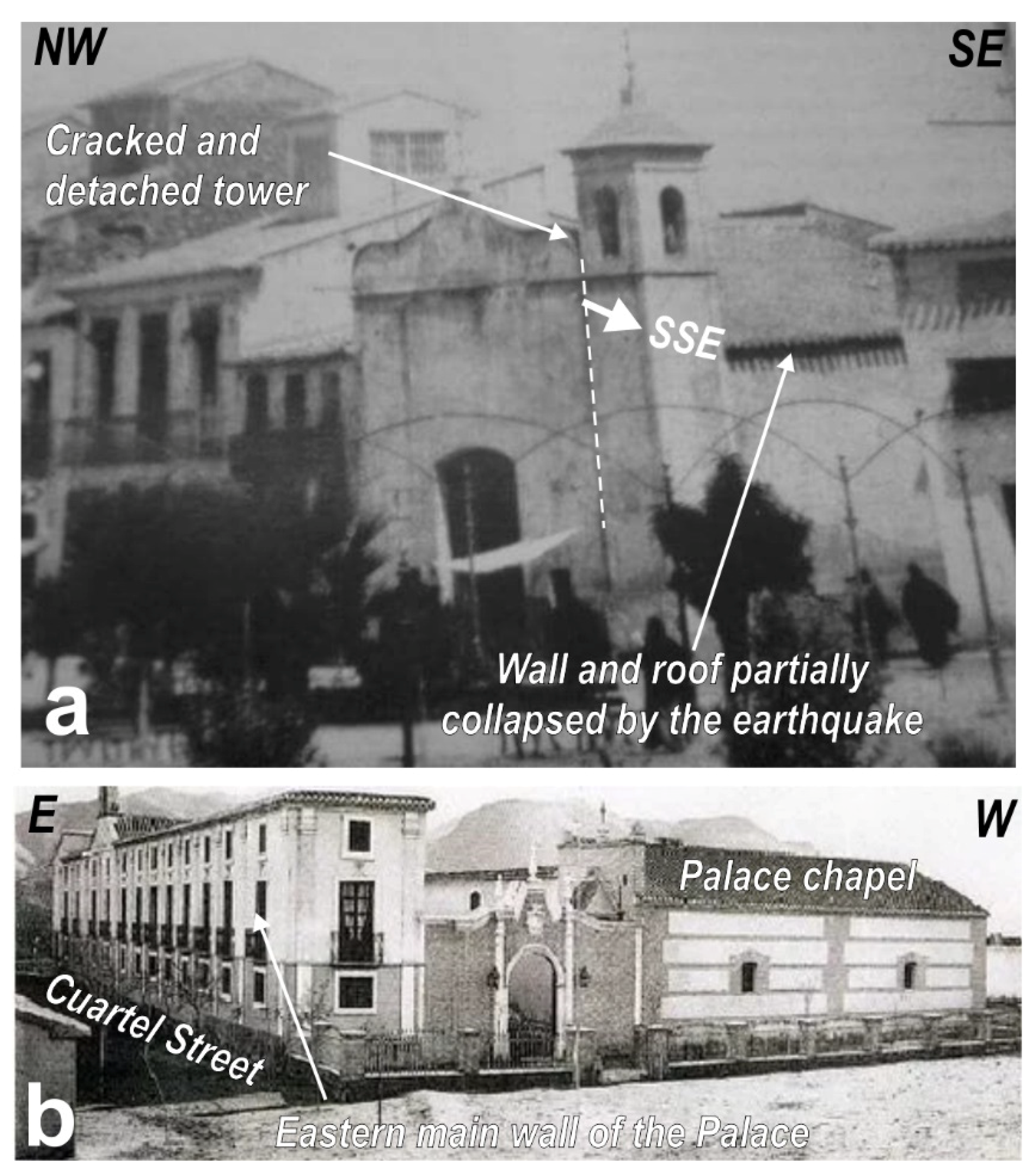
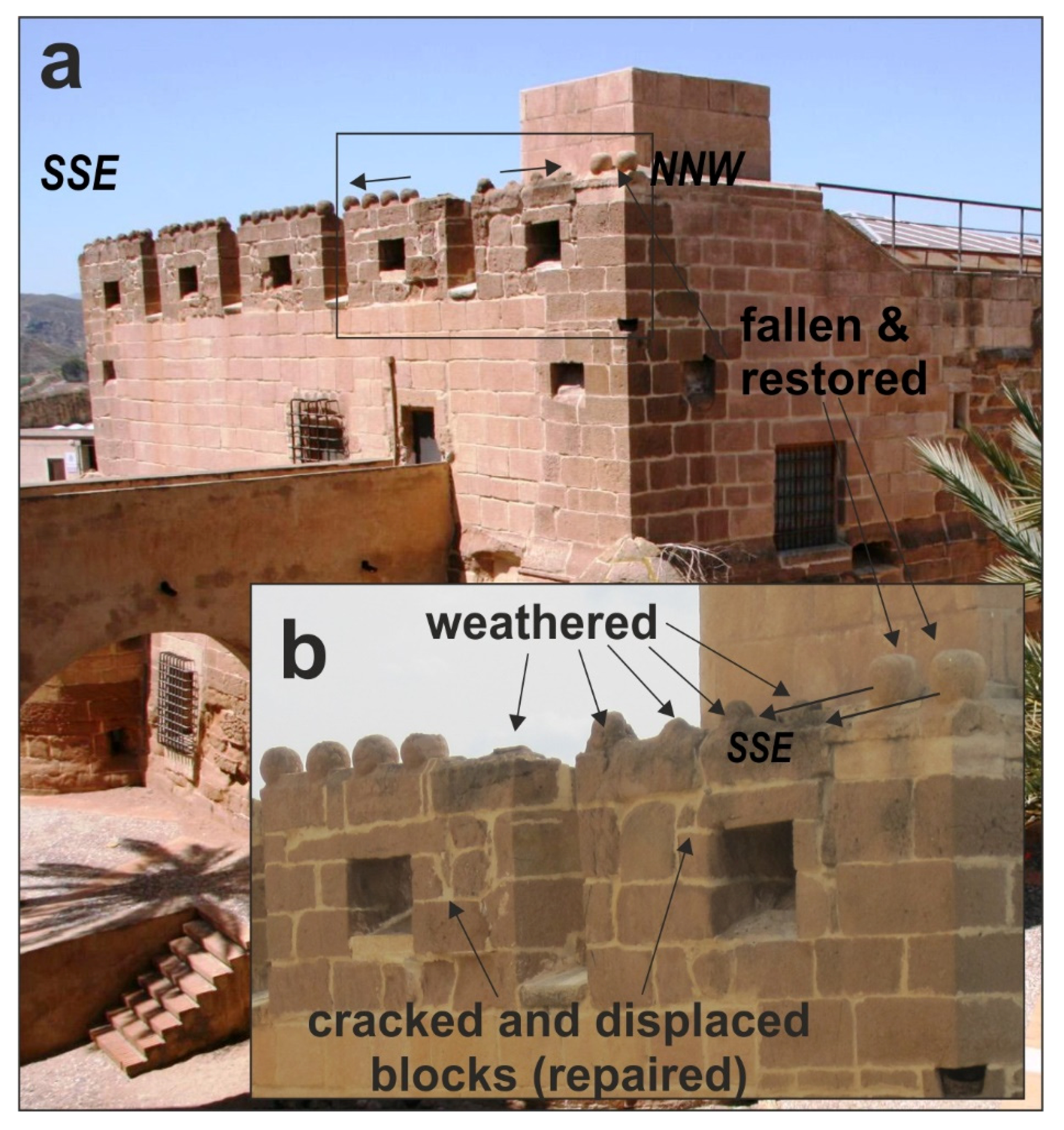
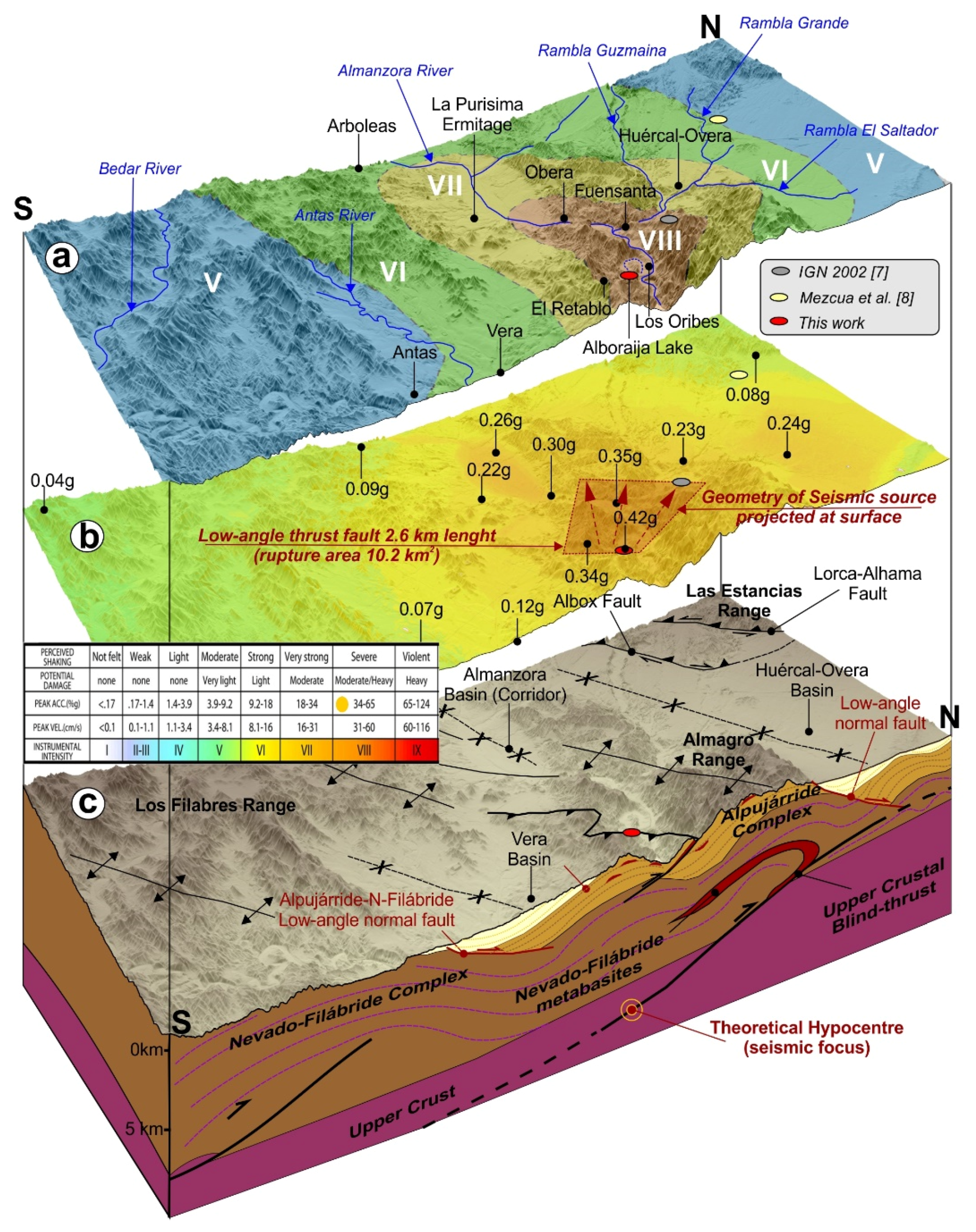
| Locality/Site (Effect) | Longitude | Latitude | Distance (km) | EMS-98 | ESI-07 |
|---|---|---|---|---|---|
| 01 Albojaira Lake (WA) | 1°55′42.8″ W | 37°20′30.7″ N | 2.8 | No Data | VIII-IX |
| 02 Albojaira Lake (GK) | 1°55′55.4″ W | 37°20′36.7″ N | 2.6 | No Data | VIII-IX |
| 03 Bobara, La Fuensanta Spring (HD) | 1°56′37.1″ W | 37°21′36.3″ N | 1.2 | No Data | VIII |
| 04 Santa Barbara, Watermills (WA) | 1°57′51.0″ W | 37°20′55.0″ N | 3.5 | No Data | VIII |
| 05 El Retablo Hill springs (HD) | 1°56′14.9″ W | 37°19′48.0″ N | 4.1 | No Data | VIII |
| 06 Almanzora Canyon (SM) | 1°56′26.4″ W | 37°20′52.1″ N | 2.1 | No Data | VIII |
| 07 Obera Antigua, Castle Hill (GK) | 1°57′44.1″ W | 37°21′2.2″ N | 3.1 | No Data | VII |
| 08 Huércal, El Caño Spring (HD) | 1°56′34.4″ W | 37°23′8,9″ N | 2.5 | VI-VII | VII |
| 09 Huércal, Carretera St. (GK) | 1°56′31.6″ W | 37°23′9.2″ N | 2.3 | VI-VII | VII |
| 10 Huércal (OT: Gas Emissions) | 1°56′31.6″ W | 37°23′9.2″ N | 2.4 | VI-VII | VII |
| 11 Huércal, El Saltador R. (SM) | 1°56′4.4″ W | 37°23′15.87” N | 2.3 | VI-VII | VII |
| 12 Huércal, Grande R. (SM) | 1°56′19.0″ W | 37°22′57,50″ N | 1.9 | VI-VII | VII |
| 13 Huércal, (OT: Tree shaking) | 1°56′17.1″ W | 37°23′8.4″ N | 2.2 | VI-VII | VII |
| 14 Huércal, Piedras Rajadas (SM) | 1°56′58.2” W | 37°22′51.8″ N | 2.1 | VI-VII | VII |
| 15 Los Oribes, Caserío (SM) | 1°55′30.1” W | 37°20′28.7″ N | 2.9 | No Data | VII |
| 16 Tres Pacos Mine Spring (HD) | 1°52′19.8″ W | 37°20′4.2″ N | 6.5 | No Data | VII |
| 17 Cuevas de Almanzora (GK) | 1°52′46.6″ W | 37°17′49.3″ N | 8.9 | V-VI | VI |
| 18 Cuevas de Almanzora (SM) | 1°53′9.1″ W | 37°17′58.5″ N | 8.5 | V-VI | VI |
| 19 Cuevasa, El Portillo Hill (SM) | 1°51′38.0″ W | 37°17′58.7″ N | 8.8 | No Data | VI |
| 20 La Jarosa, Constancia Mine (HD) | 1°44′58.0”W | 37°17′47.7″ N | 17.6 | No Data | V |
| 21 La Jarosa, San Antonio Mine (OT: Spontaneous ventilation) | 1°44′55.8″ W | 37°17′48.7″ N | 17.4 | No Data | VI |
| 22 Vera (OT: Gas Emissions) | 1°52′5.8″ W | 37°14′46.9″ N | 15.5 | VI | VI |
| 23 El Taberno, Spring (?) (OT) | 2°4′37.8″ W | 37°28′5.9″ N | 17.0 | Natural Effects | IV-V |
| Locality, Site | Longitude | Latitude | Distance (km) | EMS-98 | ESI-07 (Zone) |
|---|---|---|---|---|---|
| 24 Obera Antigua, Castle (ruins) | 1°57′44.1″ W | 37°21′2.2″ N | 3.1 | No Data | VII |
| 25 Obera La Purísima Chapel * | 1°59′34.6″ W | 37°20′23.5″ N | 5.9 | No Data | VII |
| 26 Huércal-Overa La Asunción Church | 1°56′34.9″ W | 37°23′20.9″ N | 2.6 | VI-VII | VII |
| 27 Huércal-Overa Santo Sepulcro * | 1°56′35.5″ W | 37°23′22.7″ N | 2.7 | VI-VII | VII |
| 28 Huércal-Overa Angustias Church | 1°56′42.5″ W | 37°23′26.2″ N | 2.9 | VI-VII | VII |
| 29 Huércal-Overa, Castle (ruins) | 1°56′07.2″ W | 37°23′12.8″ N | 2.3 | VI-VII | VII |
| 30 Huércal-Overa, City Hall | 1°56′37.2″ W | 37°23′26.2″ N | 2.6 | VI-VII | VII |
| 31 Cuevas, Villafranca Castle | 1°52′58.1″ W | 37°17′49.5″ N | 9.1 | V-VI | VI |
| 32 Cuevas, Santo Sepulcro Chapel | 1°52′41.8″ W | 37°17′42.7″ N | 9.3 | V-VI | VI |
| 33 Vera, Padres Mínimos Convent | 1°52′04.9″ W | 37°14′51.6″ N | 15.5 | VI | VI |
| 34 Almanzora, Palacio de Almanzora | 2°8′05.9″ W | 37°20′51.5″ N | 18.1 | No Data | VI |
| 35 Santa María de Nieva Church * | 1°59′22.6″ W | 37°27′38.2″ N | 12.8 | No Data | ≤V |
| 36 Serón Castle | 2°30′37.2″ W | 37°20′36.3″ N | 51.3 | Felt (≤V) | ≤V |
| Locality | Longitude | Latitude | Distance (km) | EMS-98 | ESI-07 |
|---|---|---|---|---|---|
| 01 Huércal Overa * | 1°56′34.9″ W | 37°23′20.92″ N | 2.6 | VI-VII | VII |
| 02 Cuevas Almanzora * | 1°52′58.1″ W | 37°17′49.5″ N | 9.1 | V-VI | VI |
| 03 Vera * | 1°52′04.8″ W | 37°14′51.6″ N | 15.5 | VI | VI |
| 04 Arboleas * | 2°4′30,1″ W | 37°21′7,3″ N | 12.5 | V-VI | VI (Zone) |
| 05 Albox* | 2°9′03.4″ W | 37°23′12.9″ N | 19.1 | IV-V | V (Zone) |
| 06 Cantoria * | 2°11′33.9″ W | 37°21′9.1″ N | 22.9 | IV-V | V (Zone) |
| 07 Antas | 1°55′02.5″ W | 37°14′43.4″ N | 13.5 | Felt (≤V) | V (Zone) |
| 08 Villaricos | 1°46′29.3″ W | 37°14′43.4″ N | 18.9 | Felt (≤V) | V (Zone) |
| 09 Lubrín | 2°3′058.8″ W | 37°12′55.8″ N | 20.0 | Felt (≤V) | No Data |
| 10 Garrucha | 1°49′18.3″ W | 37°11′4.4″ N | 22.2 | Felt (≤V) | No Data |
| 11 Purchena | 2°21′40.0″ W | 37°20′51.3″ N | 37.8 | Felt (≤V) | No Data |
| 12 Serón | 2°30′39.1″ W | 2°21′40.0″ N | 51.7 | Felt (≤V) | No Data |
| 13 Águilas | 1°34′52.4″ W | 37°24′5.2″ N | 31.2 | III | No Data |
| 14 Lorca | 1°41′58.3″ W | 37°40′32.0″ N | 40.8 | III | No Data |
| 15 Almería | 2°28′2.9″ W | 36°50′16.6″ N | 75.0 | III | No Data |
| 16 Cartagena | 0°58′58.6″ W | 37°36′7.8″ N | 87.8 | III-IV | No Data |
© 2020 by the authors. Licensee MDPI, Basel, Switzerland. This article is an open access article distributed under the terms and conditions of the Creative Commons Attribution (CC BY) license (http://creativecommons.org/licenses/by/4.0/).
Share and Cite
Silva, P.G.; Elez, J.; Giner-Robles, J.L.; Pérez-López, R.; Roquero, E.; Rodríguez-Pascua, M.Á. Reappraisal of the 1863 Huércal-Overa Earthquake (Betic Cordillera, SE Spain) by the Analysis of ESI-07 Environmental Effects and Building Oriented Damage. Geosciences 2020, 10, 303. https://doi.org/10.3390/geosciences10080303
Silva PG, Elez J, Giner-Robles JL, Pérez-López R, Roquero E, Rodríguez-Pascua MÁ. Reappraisal of the 1863 Huércal-Overa Earthquake (Betic Cordillera, SE Spain) by the Analysis of ESI-07 Environmental Effects and Building Oriented Damage. Geosciences. 2020; 10(8):303. https://doi.org/10.3390/geosciences10080303
Chicago/Turabian StyleSilva, Pablo G., Javier Elez, Jorge L. Giner-Robles, Raúl Pérez-López, Elvira Roquero, and Miguel Ángel Rodríguez-Pascua. 2020. "Reappraisal of the 1863 Huércal-Overa Earthquake (Betic Cordillera, SE Spain) by the Analysis of ESI-07 Environmental Effects and Building Oriented Damage" Geosciences 10, no. 8: 303. https://doi.org/10.3390/geosciences10080303
APA StyleSilva, P. G., Elez, J., Giner-Robles, J. L., Pérez-López, R., Roquero, E., & Rodríguez-Pascua, M. Á. (2020). Reappraisal of the 1863 Huércal-Overa Earthquake (Betic Cordillera, SE Spain) by the Analysis of ESI-07 Environmental Effects and Building Oriented Damage. Geosciences, 10(8), 303. https://doi.org/10.3390/geosciences10080303








